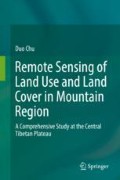Abstract
Land-use change models are tools to support the analysis of the causes and consequences of land-use dynamics. Scenario analysis with land-use models can support land-use planning and policy. In this study, Markov chain model, which describes land-use and land-cover change from one period to another and uses this as the basis to predict future changes, is applied to project land-use changes in the future for Lhasa area located at the central Tibetan Plateau over a 20-year period from 2000 to 2020 based on the land-use change dynamics and transition probability matrix from 1990 to 2000, and comparison analysis between areas from land-use planning and Markov model projection is made. Results indicated that Markov chain model is found to be useful tool for describing and predicting land-use change process in the study area, and the general trends of future land-use change in the study area are effectively captured, which shows that cultivated land, grassland, water body, and unused land-use types would decrease, whereas forest, horticultural, and built-up land would continue to increase. Studying land-use changes in the past few years and predicting these changes in the future years to come may play a significant role in planning and optimal use of natural resources and harnessing the non-normative changes in the future.
Access this chapter
Tax calculation will be finalised at checkout
Purchases are for personal use only
References
Baker, W.L. 1989. A review of models of landscape change. Landscape Ecology 2: 111–133.
Brown, D.G., B.C. Pijanowski, and J.D. Duh. 2000. Modelling the relationships between land use and land cover on private lands in the Upper Midwest, USA. Journal of Environmental Management 59: 247–263.
Clarke, K.C., and L.J. Gaydos. 1998. Loose-coupling a cellular automaton model and GIS: Long-term urban growth prediction for San Francisco and Washington/Baltimore. International Journal of Geographical Information Science 12: 699–714.
Clarke, K.C., S. Hoppen, and L. Gaydos. 1997. A self-modifying cellular automaton model of historical urbanization in the San Francisco Bay area. Environment and Planning B: Planning and Design 24: 247–261.
Costanza, R., and M. Ruth. 1998. Using dynamic modeling to scope environmental problems and build consensus. Environmental Management 22: 183–195.
Findell, K.L., A. Berg, P. Gentine, et al. 2017. The impact of anthropogenic land use and land cover change on regional climate extremes. Nature Communications 8 (1): 1–10.
Geohegan, J., L.A. Wainger, and N.E. Bockstael. 1997. Spatial landscape indices in a hedonic framework: An ecological economics analysis using GIS. Ecological Economics 23: 251–264.
Iacono, M., D. Levinson, A. El-Geneidy, et al. 2015. A Markov chain model of land use change in the Twin Cities, 1958–2005. Journal of Land Use, Mobility and Environment 8 (3): 263–276.
Kumar, S., N. Radhakrishnan, and S. Mathew. 2014. Land use change modelling using a Markov model and remote sensing. Geomatics, Natural Hazards and Risk 5 (2): 145–156.
Lambin, E.F. 1997. Modelling and monitoring land-cover change processes in tropical regions. Progress in Physical Geography 21: 375–393.
Lambin, E.F., X. Baulies, N. Bockstael, et al. 2000. Land-Use and Land-Cover Change (LUCC), Implementation Strategy, IGBP Report 48, IHDP Report 10, IGBP, IHDP. Bonn: Stockholm.
Landis, J.D. 1994. The California urban future model: A new-generation of metropolitan simulation-models. Environment and Planning B 21: 399–420.
Levinson, D., and W. Chen. 2005. Paving new ground: A Markov chain model of the change in transportation networks and land use. In Access to Destinations, ed. D. Levinson and K. Krizek, 243–266. Amsterdam/Boston: Elsevier Science.
McMillen, D., and J. McDonald. 1991. A Markov chain model of zoning change. Journal of Urban Economics 30: 257–270.
Muller, R.M., and J. Middleton. 1994. A Markov model of land-use change dynamics in the Niagara region, Ontario, Canada. Landscape Ecology 9: 151–157.
Rhoades, R. 1997. Pathways Towards a Sustainable Mountain Agriculture for the 21st Century: The Hindu Kush-Himalayan Experience. Kathmandu: ICIMOD.
Stewart, W.J. 1994. Introduction to the Numerical Solution of Markov Chains. Princeton: Princeton University Press.
Stokey, E., and R. Zeckhauser. 1978. A Primer for Policy Analysis. New York/London: W.W. Norton.
TAR government. 1998. Master Plan for Land Us in Tibet Autonomous Region from 1997 to 2010 (unpublished report). pp. 10–47.
Theobald, D.M., and N.T. Hobbs. 1998. Forecasting rural land-use change: A comparison of regression and spatial transition-based models. Geographical and Environmental Modelling 2: 65–82.
Turner, M. 1987. Spatial simulation of landscape changes in Georgia: A comparison of three transition models. Landscape Ecology 1 (1): 29–36.
Turner, B.L. 1994. Local faces, global flows: The role of land use and land cover in global environmental change. Land Degradation and Rehabilitation 5: 71–78.
Turner, B.L., D. Skole, S. Sanderson, et al. 1995. Land Use and Land Cover Change (LUCC): Science/Research Plan, IGBP Report No. 35, HDP Report No. 7. Geneva: Stovkholm.
Verburg, P.H., and A. Veldkamp. 2005. Introduction to the special issue on spatial modeling to explore land use dynamics. International Journal of Geographical Information Science 19 (2): 99–102.
Verburg, P.H., P.P. Schot, M.J. Dijst, et al. 2004. Land use change modelling: Current practice and research priorities. GeoJournal 61 (4): 309–324.
Vitousek, P.M. 1994. Beyond global warming: Ecology and global change. Ecology 75 (7): 1861–1876.
Vitousek, P.M., H.A. Mooney, J. Lubchenco, et al. 1997. Human domination of earth’s ecosystems. Science 277: 494–499.
Weng, Q. 2002. Land use change analysis in the Zhujiang Delta of China using satellite remote sensing, GIS and stochastic modelling. Journal of Environmental Management 64: 273–284.
Zhang, Z., and D. Chu. 1998. Integrated Environmental Assessment in the Central Tibet Using Remote Sensing and GIS. Beijing: Yuhang Press.
Author information
Authors and Affiliations
Rights and permissions
Copyright information
© 2020 Springer Nature Singapore Pte Ltd.
About this chapter
Cite this chapter
Chu, D. (2020). Land-Use Change Scenario. In: Remote Sensing of Land Use and Land Cover in Mountain Region. Springer, Singapore. https://doi.org/10.1007/978-981-13-7580-4_6
Download citation
DOI: https://doi.org/10.1007/978-981-13-7580-4_6
Published:
Publisher Name: Springer, Singapore
Print ISBN: 978-981-13-7579-8
Online ISBN: 978-981-13-7580-4
eBook Packages: Earth and Environmental ScienceEarth and Environmental Science (R0)

